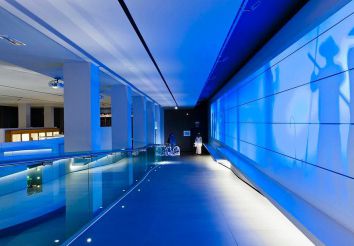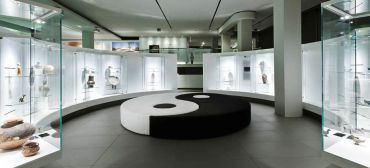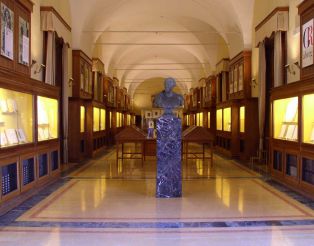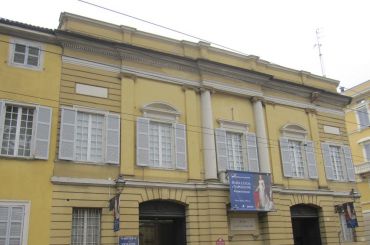Museum of Chinese Art and Ethnographic, Parma

Museum of Chinese Art and Ethnographic (Museo d'Arte Cinese ed Etnografico) in Parma is perhaps one of the most unusual and interesting museums in the region. And also one of the most modern and high-tech. Here you can see the works of art and life not only in China, but also of the peoples of Central and South America. Thus, the management of the museum brings the culture of once distant countries and peoples closer to us.
History of the museum
It all started back in 1895, when Guido Maria Conforti founded the Istituto Saveriano, a male missionary society. In 1898, Senator, Count Fedele Lampertico, gave the organization some Chinese works of art from an exhibition in Turin. Then the idea of creating a museum was born. In 1901 the construction of the Mother's House of the missionaries-ksaverians was over, the building of which became the container of museum collections. And in the same year, the first Catholics, who returned from the mission in China, brought exhibits to the institution. In subsequent years, the collection was significantly enriched, and in 1936 a new exhibition opened. In 1948, all missionaries from China were expelled, and the supply of exhibits ceased for many years.
During the Second World War, collections were kept in a villa in the commune of Basilicanova, and in 1950 they were returned back. In the period 1957-1959 the exhibition space was reorganized. And by 1965 the collection was enriched with new items from the countries of the American continent, brought by missionaries. Then they created the first museum catalog. In 2010, a large-scale reconstruction of the museum began. It was reopened for visitors on December 1, 2012, becoming ultramodern.
Exposition of the museum
The institution is one of the most important museums of Chinese art in Europe. Its mission remains unchanged: to make humanity without borders, to appreciate our rich diversity. Here you can find rare examples of art and life of many countries, cultures and peoples. This amazing material shows different ways of living and thinking around the world. The museum collection is housed in several rooms on the ground floor of the headquarters building of the missionaries, as well as in its basement. On the first floor there are ethnographic collections that are not related to China:
- Kayapo People. This is the largest collection in Italy, collected by Renato Trevisan, who lived for about 30 years among the tribe of the Amazonian forests. It includes more than 500 items: body painting, weapons, a collection of myths, works of art, crafts, and many decorations. Among the latter – a diadem made out of tail feathers of parrots macaw.
- African art. The collection is gathered mainly in the Republic of Congo, as well as in Sierra Leone and Cameroon. It makes the visitor understand the mysterious and fascinating culture of the peoples of Africa. Various masks, statues, symbols of power, ritual objects are displayed here. It includes a curious rope of wisdom, and different objects and inscriptions with the customs and proverbs of the peoples of the Congo are attached to it.
The basement of the building is completely occupied with the core of the collection – the richest collections of Chinese art. They show a vivid picture of this great civilization, not only of the beginning of the 20th century, but also of the previous centuries. A huge number of exhibits, including ceramics, porcelain, bronze objects, paintings, silks, coins and ornaments, are divided into several thematic groups:
- Pottery and porcelain. Ceramics was widely distributed and accessible to all segments of the population of China, therefore it occupies an important place in the culture of the country. And porcelain is one of the most famous inventions of the Celestial Empire. Among the exhibits are vases, bowls, dishes, droppers, amphorae, cups and figurines.
- Bronze. Products made of this metal are one of the most effective ways of describing civilization. It is even more surprising that bronze began to be used in China later than in Europe, but artisans quickly reached the peak of mastery in its processing. The collection has tables, vases, statuettes, various instruments.
- Paintings. In the collection there are more than 100 paintings, sketches and inscriptions. Only a small part is exhibited from time to time for safety reasons.
- Religion. Various figurines and ritual objects of Taoism, Confucianism and Buddhism are presented here, as well as popular beliefs prevalent in China.
- Coins and ornaments. The numismatic collection Rossi Scalzi has more than 5000 coins. Among them, a considerable number of interesting amulets can be distinguished.
Also, a lot of furniture, household items, clothes and musical instruments are stored in Chinese collections. The institution has a separate section illustrating the mission of the museum, with a series of films, photographs and a brief overview of the cultures of different nations in which the missionaries lived. There are also a number of statues of the most famous figures among the missionary society, located in the halls for temporary exhibitions.
How to get there
The museum is located slightly away from the center of Parma, on Viale S. Martino, 8. It is surrounded by several parks, and the Parma River flows nearby. Near the museum there are bus stops Viale Rustici (route 13) and Seminario Minore (routes 2, 12, 15).
Opening hours: Tuesday to Saturday from 9:00 to 14:00, bookings are possible until 17:00. Sunday, Monday and public holidays are days off. Phone number: (+39) 0521 257337.
Admission: voluntary donation.






